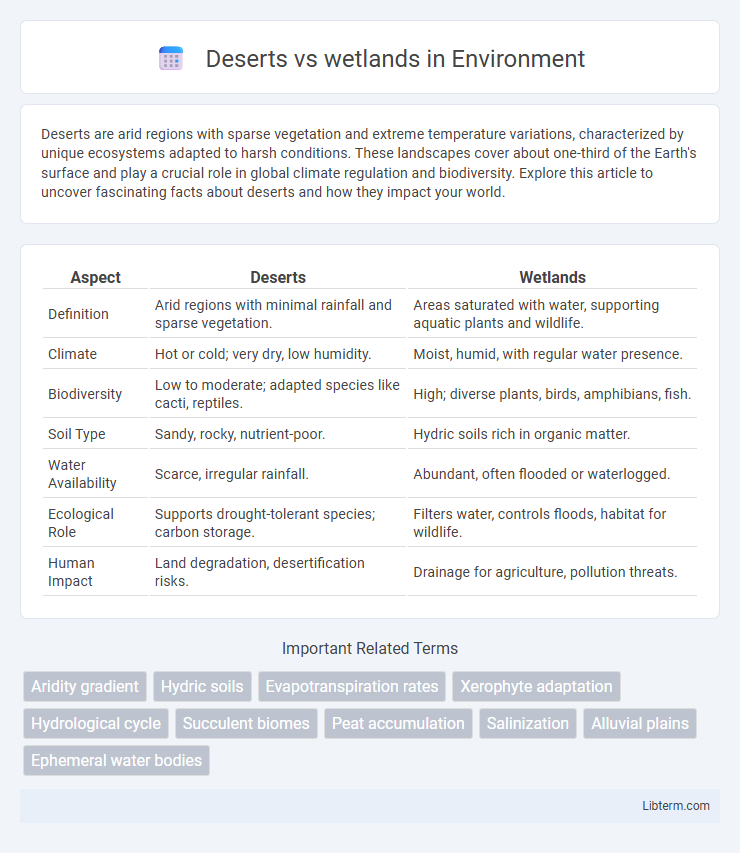Deserts are arid regions with sparse vegetation and extreme temperature variations, characterized by unique ecosystems adapted to harsh conditions. These landscapes cover about one-third of the Earth's surface and play a crucial role in global climate regulation and biodiversity. Explore this article to uncover fascinating facts about deserts and how they impact your world.
Table of Comparison
| Aspect | Deserts | Wetlands |
|---|---|---|
| Definition | Arid regions with minimal rainfall and sparse vegetation. | Areas saturated with water, supporting aquatic plants and wildlife. |
| Climate | Hot or cold; very dry, low humidity. | Moist, humid, with regular water presence. |
| Biodiversity | Low to moderate; adapted species like cacti, reptiles. | High; diverse plants, birds, amphibians, fish. |
| Soil Type | Sandy, rocky, nutrient-poor. | Hydric soils rich in organic matter. |
| Water Availability | Scarce, irregular rainfall. | Abundant, often flooded or waterlogged. |
| Ecological Role | Supports drought-tolerant species; carbon storage. | Filters water, controls floods, habitat for wildlife. |
| Human Impact | Land degradation, desertification risks. | Drainage for agriculture, pollution threats. |
Introduction to Deserts and Wetlands
Deserts are arid ecosystems characterized by low precipitation, extreme temperature fluctuations, and sparse vegetation, supporting specialized flora and fauna adapted to harsh conditions. Wetlands are water-saturated environments rich in biodiversity, playing crucial roles in water purification, flood control, and carbon sequestration. Both ecosystems are vital for ecological balance, yet they contrast sharply in hydrology, climate, and biological communities.
Key Characteristics of Deserts
Deserts are characterized by extremely low precipitation, often less than 250 millimeters annually, which leads to sparse vegetation and arid soil conditions. They experience significant temperature fluctuations between day and night due to minimal cloud cover and lack of moisture. Adaptations such as water-conserving plants like cacti and nocturnal animals are common in deserts to survive the harsh, dry climate.
Key Characteristics of Wetlands
Wetlands are characterized by saturated soils, standing water, and diverse plant species adapted to high moisture conditions, such as cattails and mangroves. These ecosystems provide critical services including water filtration, flood control, and habitats for numerous aquatic and terrestrial species. In contrast to deserts, wetlands maintain high biodiversity and nutrient-rich environments due to constant water availability.
Climate Differences: Dryness vs Moisture
Deserts exhibit extremely low precipitation levels, often receiving less than 250 millimeters annually, resulting in arid conditions and limited vegetation. Wetlands maintain high moisture content with water-saturated soils and frequent flooding, supporting diverse plant and animal species adapted to humid environments. Temperature variations in deserts lead to intense daytime heat and cold nights, while wetlands typically experience moderate temperatures stabilized by their abundant water presence.
Biodiversity: Flora and Fauna Comparison
Deserts exhibit low biodiversity with specialized flora such as cacti and succulents adapted to arid conditions, while fauna includes reptiles, rodents, and nocturnal animals that survive extreme temperatures. Wetlands support rich biodiversity with diverse plant species like reeds, cattails, and mangroves, providing habitat for amphibians, waterfowl, fish, and numerous invertebrates. The contrasting ecosystems reflect adaptations to water availability, with wetlands fostering higher species richness and complex food webs compared to the sparse, resource-scarce desert environments.
Ecosystem Services and Environmental Roles
Deserts provide critical ecosystem services such as carbon sequestration through specialized vegetation and support unique biodiversity adapted to arid conditions, while wetlands offer vital water filtration, flood control, and habitat for diverse aquatic species. Wetlands act as natural buffers against storms and improve water quality by trapping pollutants, whereas deserts play a significant role in regulating local climate and serving as reservoirs of genetic diversity. Both ecosystems contribute to maintaining global ecological balance but differ significantly in hydrological functions and biodiversity support.
Human Interaction and Impact
Human interaction with deserts often involves resource extraction such as mining and off-road vehicle use, leading to habitat degradation and soil erosion. Wetlands face significant impacts from urban development, agriculture, and pollution, resulting in loss of biodiversity and water quality decline. Both ecosystems require targeted conservation efforts to mitigate human-induced damage and preserve ecological functions.
Adaptations of Organisms in Each Habitat
Desert organisms exhibit adaptations such as water conservation mechanisms, nocturnal behavior, and specialized body structures to minimize water loss and survive extreme heat. Wetland species possess adaptations including tolerance to waterlogged soils, specialized root systems for oxygen acquisition, and behaviors suited for fluctuating water levels. These distinct adaptive traits enable survival and ecological success in the contrasting environments of deserts and wetlands.
Threats and Conservation Challenges
Deserts face increasing threats from climate change, unsustainable water extraction, and habitat fragmentation, resulting in biodiversity loss and desertification. Wetlands encounter severe pressures from urbanization, pollution, and invasive species, leading to diminished water quality and disrupted ecosystems. Conservation challenges include balancing human resource demands with habitat protection, restoring degraded areas, and implementing effective policies for sustainable management.
Conclusion: Contrasts and Connections
Deserts and wetlands represent distinct ecosystems characterized by extreme differences in moisture levels, biodiversity, and ecological functions. While deserts support specially adapted flora and fauna thriving in arid conditions, wetlands host diverse species reliant on abundant water resources and serve critical roles in water filtration and flood control. Despite these contrasts, both ecosystems are vital for global biodiversity and climate regulation, highlighting the interconnectedness of natural habitats in maintaining ecological balance.
Deserts Infographic

 libterm.com
libterm.com